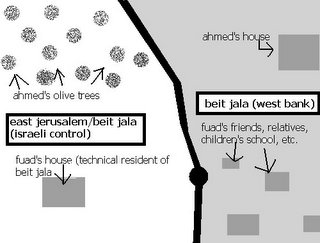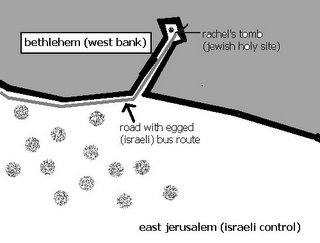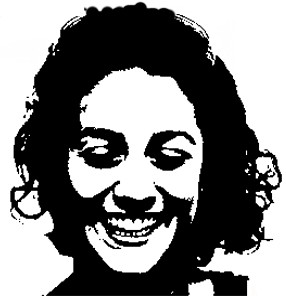"balls to walls"
officially, fuad is a resident of beit jala, a community in the west bank. he graciously served us tea at the abandoned building next to his home as he described how his property, on the outskirts of his west bank town, has recently been incorporated as part of israeli-controlled east jerusalem through the construction of the separation barrier, while the rest of his town has been fenced off. the concrete wall prevents him from accessing his community, relatives, friends, children’s school and more. he has a piece of paper permitting him entry into israel (from which regular beit jala residents are prohibited) but it can still take hours, or even an entire night to cross the checkpoint.

(i have no digital camera- diagrams will have to suffice)
earlier this week b’tselem (http://www.btselem.org/English/index.asp), an israeli human rights organization, took the staff and volunteers from my office (sadaka reut) on a tour of the “separation barrier” that israel is in the process of building. despite everything I had seen, heard and read about the wall, seeing this much of it all at once was almost like being punched in the face, or perhaps, like watching thousands of palestinians get punched in the face.
some historical background: in june, 1967 israel gained control over the west bank, including east jerusalem (as well as gaza, the golan heights and the sinai peninsula). in order to procure jerusalem as the "eternal and undivided" capital of the jewish state, east jerusalem was annexed to the state of israel while the rest of the west bank remained offically occupied territory. despite this drastic effort, east jerusalem remains the desired capital of the palestinian people and the city remains (at least socially, culturally, and economically) immensely divided. trash collection occurs regularly only in west jerusalem and other jewish neighborhoods. arab east jerusalemites are ever so privileged to have the status of permanent residents (not citizens) of israel. and as a permanent resident, one should expect to be denied building permits, even when diaspora jews are allowed to build apartment complexes in the middle of east jerusalem arab neighborhoods. we drank more tea in the legal portion of abu said’s home. the second floor that is under construction for his son is illegal, but he thought it more likely go unnoticed by the authorities than a whole new structure.
in this tiny country, land and demographics are of the utmost importance to politics. the wall is carefully winding its way around the fringes of jerusalem in what comes off as a last ditch effort to assert territorial control. it’s the political equivalent of an animal peeing to mark its territory.
its hard to dispute the fact that israel has security concerns and under the guise of defense, the government claims to be building this complex structure of concrete walls, watchtowers, fences and barbed wire, to keep out terrorists. but watching the fence twist and turn in peculiar patterns (with little regard for the green line or the communities through which it passes) makes it fairly obvious that this barrier is about more than security.

interestingly enough, half of the residents of abu dis are a security concern to the state of israel, while their neighbors on the west side of town are not. the abu dis portion of the wall has been featured on international news because it literally divides the community in two, leaving a small hole in the fence, guarded by israeli soldiers as the only place people can cross to carry on their lives. it is tagged with graffiti: “seattle/india/ireland/etc supports palestine,” “from warsaw ghetto to abu dis ghetto” and the ever clever, “balls to walls.”
 the community of sheikh sayeed may soon meet a similar fate. we spoke with some of its residents who told us they considered their community to be a neighborhood of jebel mukaber, which is considered by israel as part of jerusalem. however, unlike their j.m. neighbors, residents of the sheikh sayeed village do not have blue identity cards giving them the elusive “permanent resident” status because some imaginary line has deemed those in sheikh sayeed as residents of the palestinian authority. so to the west lies what israel sees as jerusalem and to the east the landscape plummets into a deep wadi with no roads out. the intended route for the separation fence is about to cut the village of sheikh sayeed off from the rest of jebel mukaber, which for all intents and purposes will turn it into a 2,000 person ghetto. in this case, even geography is against the palestinians.
the community of sheikh sayeed may soon meet a similar fate. we spoke with some of its residents who told us they considered their community to be a neighborhood of jebel mukaber, which is considered by israel as part of jerusalem. however, unlike their j.m. neighbors, residents of the sheikh sayeed village do not have blue identity cards giving them the elusive “permanent resident” status because some imaginary line has deemed those in sheikh sayeed as residents of the palestinian authority. so to the west lies what israel sees as jerusalem and to the east the landscape plummets into a deep wadi with no roads out. the intended route for the separation fence is about to cut the village of sheikh sayeed off from the rest of jebel mukaber, which for all intents and purposes will turn it into a 2,000 person ghetto. in this case, even geography is against the palestinians.
 this security fence is not an apartheid wall (i believe this conflict is too unique to appropriate terms from elsewhere), but it is definitely wronging an entire population. and if im still reeling from the tour, I cant even imagine how they feel.
this security fence is not an apartheid wall (i believe this conflict is too unique to appropriate terms from elsewhere), but it is definitely wronging an entire population. and if im still reeling from the tour, I cant even imagine how they feel.


 the community of sheikh sayeed may soon meet a similar fate. we spoke with some of its residents who told us they considered their community to be a neighborhood of jebel mukaber, which is considered by
the community of sheikh sayeed may soon meet a similar fate. we spoke with some of its residents who told us they considered their community to be a neighborhood of jebel mukaber, which is considered by  this security fence is not an apartheid wall (i believe this conflict is too unique to appropriate terms from elsewhere), but it is definitely wronging an entire population. and if im still reeling from the tour, I cant even imagine how they feel.
this security fence is not an apartheid wall (i believe this conflict is too unique to appropriate terms from elsewhere), but it is definitely wronging an entire population. and if im still reeling from the tour, I cant even imagine how they feel.


2 Comments:
At 8:00 PM, Anonymous said…
Anonymous said…
hannah, i truly appreciate this mini lesson on an area of your expertise and my ignorance. but i feel obligated to point out that your first diagram has west on the right and east on the left which leaves me with a feeling of extreme discomfort as it goes against most mapping customs (at least the ones that i am familiar with). maybe you are trying to pictorially parallel your confusion and frustration with the current political situation, or possibly the right to left nature of both the hebrew and arabic languages (one commonality between a harshly divided people). dont get me wrong, your diagrams are a tribute to all that can be done with paintbrush (i especially appreciate your use of the spray paint function), and are quite informative.
my enter key works now. i mean, hey, what's up, from before.
At 7:45 PM, sarah buchalo said…
sarah buchalo said…
Hannah, I went to go see "Paradise Now" last night after your strong recommendation. I came back to this post after seeing the film and find it even more interesting and useful in understanding what is going on in that area. I think your paint diagrams are beautiful and am so glad you're keeping this blog.
Love, Sarah
Post a Comment
<< Home